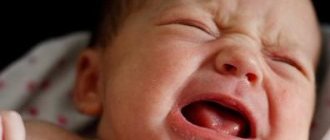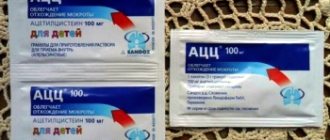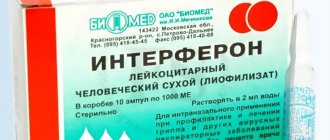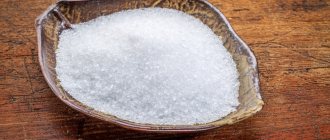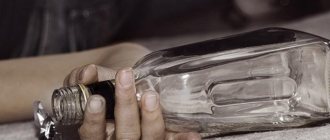Release form and composition
Dosage form of chorionic gonadotropin is a lyophilisate for the preparation of a solution for intramuscular (i.m.) administration: lyophilized almost white or white powder (in glass tube bottles, in blister packs, 5 bottles complete with 5 ampoules of solvent, 1 ml each, in a cardboard 1 pack per pack).
Composition of 1 bottle:
- active substance: human chorionic gonadotropin – 500, 1000, 1500 or 5000 IU (international units);
- auxiliary component: mannitol (mannitol) – 20 mg.
Solvent: 0.9% sodium chloride injection solution – 1 ml.
Analogs
The following medications can be used together with Gonadotropin 1000:
- Decayed;
- Horagon.
The first of the drugs contains the same substances as Gonadotropin, but the concentration of the main component is higher and amounts to 1500 units. In addition, the cost of this medicine is much lower. Another drug (Choragon) represents a higher price category. Available in two versions: 1500 and 5000 units. The drug is a single component, containing only human chorionic gonadotropin.
The set of contraindications and restrictions is the same in all cases. However, the larger the dose of the drug, the higher the risk of complications; for this reason, the condition of the body should be monitored. The advantage of a hormonal drug with a large dosage of gonadotropin is ease of use if 5000 or 1000 units are prescribed.
Pharmacological properties
Pharmacodynamics
Chorionic gonadotropin has a luteinizing, follicle-stimulating and gonadotropic effect, while the luteinizing activity is higher than the follicle-stimulating one.
The active substance of the drug, human chorionic gonadotropin (hCG), is a gonadotropic hormone produced by the placenta during pregnancy (excreted unchanged by the kidneys). The method of obtaining the substance for the drug is extraction from urine followed by purification.
HCG is necessary for women and men for normal growth and maturation of gametes, as well as for the production of sex hormones.
The drug stimulates the development of the genital organs and secondary sexual characteristics. In addition, it promotes ovulation and stimulates the synthesis of estrogens (estradiol) and progesterone in women, and also stimulates spermatogenesis, the production of dihydrotestosterone and testosterone in men.
Pharmacokinetics
After intramuscular administration it is well absorbed. The half-life is 8 hours.
Achieving the maximum plasma concentration of hCG in the blood is observed after 4–12 hours. The half-life of human chorionic gonadotropin is approximately 29–30 hours; with daily use, accumulation of the drug may be observed.
Chorionic gonadotropin is excreted by the kidneys. Approximately 10–20% of the administered dose is found unchanged in the urine, the main part being excreted as β-chain fragments.
Shelf life of Gonadotropin
The drug is produced in the form of a powder for the preparation of an injection solution, the shelf life is 4 years, after opening the ampoule it cannot be stored.
Where can I find the expiration date on the packaging?
The expiration date is indicated on the end of the medicine box, and is also duplicated on each ampoule inside the package.
How does temperature change affect shelf life?
Under the influence of temperatures, the active substance is destroyed. As a result, the declared shelf life is not valid, but is reduced significantly. Since the drug is thermolabile, even at temperatures above +20 ° C its destruction begins.
Is it possible to use the drug "Gonadotropin" if there are 5-10 days left before the expiration date?
The drug can be used 5-10 days before the expiration date only if the drug was stored correctly throughout the entire period from the date of manufacture. It is also necessary to evaluate the external data of the packaging and the contents themselves. If there are violations of the integrity of the bottles, then this drug cannot be used.
By what signs can you identify an expired drug?
An expired drug reveals itself as yellowed contents, an unpleasant odor and poor solubility in water. When oxygen is present, the contents dry out and are difficult to remove from the bottle.
What happens if you use an expired drug?
When using an expired drug, unpredictable consequences may occur. Once in the bloodstream, intoxication occurs, which requires medical intervention. A person experiences headache, nausea, chills and dizziness.
Why does the medicine have a long shelf life?
The medicine has a long shelf life thanks to the preservatives and stabilizers it contains. Sterile packaging helps preserve the medicine for a long time, which prevents the growth of bacteria inside the bottle.
Indications for use
Chorionic gonadotropin 1500, 1000 and 500 IU
Women:
- maintaining the corpus luteum phase;
- amenorrhea, anovulatory ovarian dysfunction.
Men and boys:
- delayed puberty associated with insufficiency of the gonadotropic function of the pituitary gland;
- hypogonadotropic hypogonadism;
- oligoasthenospermia, spermatogenesis deficiency, azoospermia;
- cryptorchidism, which is not associated with anatomical obstruction;
- conducting a functional Leydig test to assess testicular function in hypogonadotropic hypogonadism before prescribing long-term stimulating therapy;
- conducting a differential diagnostic test for cryptorchidism/anorchidism in boys.
Chorionic gonadotropin 5000 IU
Women:
- induction of ovulation in case of infertility, which is caused by anovulation or impaired follicle maturation;
- preparation of follicles for puncture in programs of controlled ovarian hyperstimulation (for methods of additional reproduction);
- maintaining the corpus luteum phase.
Men:
- hypogonadotropic hypogonadism;
- conducting a functional Leydig test to assess testicular function in hypogonadotropic hypogonadism before prescribing long-term stimulating therapy.
Contraindications
Absolute:
- hormone-dependent malignant tumors of the genital organs and breast (diagnosed or suspected), including ovarian cancer, breast cancer, uterine cancer in women, and prostate cancer, breast carcinoma in men;
- organic lesions of the central nervous system (tumors of the hypothalamus, pituitary gland);
- deep vein thrombophlebitis;
- hypothyroidism;
- adrenal insufficiency;
- hyperprolactinemia;
- premature puberty in boys (for 500, 1000 and 1500 IU);
- infertility that is not associated with hypogonadotropic hypogonadism in men;
- children under 3 years of age (for 500, 1000 and 1500 IU);
- individual intolerance to the components of the drug.
Additional absolute contraindications for the use of the drug in women:
- bleeding or spotting from the vagina of unknown origin;
- abnormal formation of the genital organs, which is incompatible with pregnancy;
- primary ovarian failure;
- fibrous tumor of the uterus, which is incompatible with pregnancy;
- indications in the anamnesis of ovarian hyperstimulation syndrome (OHSS) (for 5000 IU);
- infertility that is not associated with anovulation (for example, tubal or cervical origin, for 500, 1000 and 1500 IU);
- polycystic ovary syndrome (PCOS) (for 5000 IU);
- pregnancy and breastfeeding period.
Relative (diseases/conditions in the presence of which the use of human chorionic gonadotropin requires caution):
- risk factors for thrombosis (complicated personal/family history, severe obesity with a body mass index > 30 kg/m2, thrombophilia, etc.);
- prepubertal age in boys - for doses of 500, 1000 and 15000 IU;
- latent or obvious heart failure, renal dysfunction, arterial hypertension, epilepsy, migraine, including indications of these diseases/conditions in the anamnesis - for men;
- bronchial asthma.
Instructions for use of human chorionic gonadotropin: method and dosage
The drug is administered intramuscularly slowly, after first adding a solvent to the lyophilisate.
The dosage regimen can be adjusted individually by your doctor.
Chorionic gonadotropin 1000, 500 or 1500 IU
Women:
- anovulatory cycles: 2-3 times with an interval of 2-3 days, 3000 IU, from 10-12 days of the menstrual cycle, or 6-7 injections - every other day, 1500 IU;
- maintaining the corpus luteum phase: 2–3 injections of 1500–5000 IU for 9 days after ovulation or embryo transfer (for example, once every three days).
Men and boys:
- hypogonadotropic hypogonadism: 2–3 times a week, 1000–2000 IU. In cases of infertility, a drug containing follitropin (follicle-stimulating hormone) may be additionally prescribed. The duration of the course during which any improvement in spermatogenesis can be expected is at least 3 months. During the period of use of the drug, testosterone replacement therapy should be suspended. After improvement, in order to maintain the result, sufficiently isolated use of human chorionic gonadotropin;
- delayed puberty due to insufficiency of the gonadotropic function of the pituitary gland: 2–3 times a week, 1500 IU for a course of at least 6 months;
- cryptorchidism not caused by anatomical obstruction: 2 times a week, 500–1000 IU for children 3–6 years old or 1500 IU for children over 6 years old; if necessary, therapy is repeated;
- insufficiency of spermatogenesis, oligoasthenospermia, azoospermia: daily 500 IU in combination with menotropin (75 IU of follicle-stimulating and luteinizing hormone) or every 5 days 2000 IU in combination with menotropin (150 IU of follicle-stimulating and luteinizing hormone) 3 times a week in a course of 3 month. In cases of insufficient effect or its absence, the drug is prescribed 2-3 times a week, 2000 IU in combination with menotropin (150 IU of follicle-stimulating and luteinizing hormone) 3 times a week for a course of 3-12 months. After spermatogenesis improves, in some cases maintenance doses of human chorionic gonadotropin can be administered;
- differential diagnosis of anorchism/cryptorchidism in boys: a single dose of 100 IU/kg, the serum concentration of testosterone in the blood is determined before the test and 72–96 hours after the injection. With anorchism, the test will be negative, which is evidence of the absence of testicular tissue; with cryptorchidism, even if only one testicle is present, positive (5-10-fold increase in testosterone concentration). If the test is weakly positive, a search for the gonad (laparoscopy or abdominal ultrasound) is required, since there is a high risk of malignancy.
Chorionic gonadotropin 5000 IU
Women:
- induction of ovulation in case of infertility, which is caused by anovulation or impaired maturation of follicles, preparation of follicles for puncture in programs of controlled ovarian hyperstimulation: a single dose of 5000–10,000 IU to complete therapy with follicle-stimulating hormone drugs;
- maintaining the corpus luteum phase: 2–3 injections of 1500–5000 IU for 9 days after ovulation or embryo transfer (for example, once every three days).
Men:
- hypogonadotropic hypogonadism: 1500–6000 IU once a week. In cases of infertility, hCG can be administered with a drug containing follitropin 2-3 times a week. The duration of the course during which any improvement in spermatogenesis can be expected is at least 3 months. Testosterone replacement therapy should be suspended during this period. After improvement, in order to maintain the result, in some cases, human chorionic gonadotropin is used in isolation;
- Leydig functional test: 5000 IU daily for 3 days (at the same time). After the last injection, the next day blood is drawn and testosterone levels are examined. The sample is assessed as positive in cases where there is an increase of 30–50% or more from the initial values. It is preferable to combine this test with another spermogram on the same day.
Buy Gonadotropin hCG lyophilisate for preparing intramuscular solution 1000 units No. 5 in pharmacies
Chorionic gonadotropin Buy Chorionic gonadotropin in pharmacies DOSAGE FORMS lyophilisate for the preparation of solution for intramuscular administration 1000IU
MANUFACTURERS Moscow Endocrine Plant (Russia)
GROUP Gonadotropins and antigonadotropic drugs
COMPOSITION Active ingredient: human chorionic gonadotropin.
INTERNATIONAL NON-PROPENTED NAME Chorionic gonadotropin
SYNONYMS Pregnil, Horagon
PHARMACOLOGICAL ACTION Human chorionic gonadotropin (hCG) is a gonadotropic hormone that is produced by the placenta during pregnancy and then excreted unchanged by the kidneys. To obtain the drug, it is extracted from urine and purified. Necessary for normal growth and maturation of gametes in women and men, as well as for the production of sex hormones. Pharmacodynamics. It has a gonadotropic, follicle-stimulating and luteinizing effect. Luteinizing activity prevails over follicle-stimulating activity. Stimulates the development of genital organs and secondary sexual characteristics. In women, the drug causes ovulation and stimulates the synthesis of estrogens (estradiol) and progesterone. In men, it stimulates spermatogenesis, the production of testosterone and dihydrotestosterone. Pharmacokinetics. After intramuscular administration it is well absorbed. The half-life is 8 hours. The maximum concentration of hCG in the blood plasma is achieved after 4-12 hours. The half-life of human chorionic gonadotropin is 29-30 hours; in the case of daily intramuscular injections, accumulation of the drug may be observed. Chorionic gonadotropin is excreted by the kidneys. About 10-20% of the administered dose is found unchanged in the urine, the main part is excreted in the form of beta chain fragments.
INDICATIONS FOR USE In women: ovarian dysfunction (anovulatory), amenorrhea; maintaining the corpus luteum phase. In men and boys: hypogonadotropic hypogonadism; delayed puberty due to insufficiency of the gonadotropic function of the pituitary gland; cryptorchidism not due to anatomical obstruction; insufficiency of spermatogenesis, oligo-asthenospermia, azoospermia; when conducting a differential diagnostic test for anorchism and cryptorchidism in boys; when performing a Leydig functional test to assess testicular function in hypogonadotropic hypogonadism before starting long-term stimulating treatment.
CONTRAINDICATIONS Hypersensitivity to hCG or to any component of the drug; hormone-dependent malignant tumors of the genital organs and mammary gland currently or suspected of them (ovarian cancer, breast cancer, uterine cancer in women and prostate cancer, breast carcinoma in men); organic lesions of the central nervous system (CNS) (tumors of the pituitary gland, hypothalamus); deep vein thrombophlebitis; hypothyroidism; adrenal insufficiency; hyperprolactinemia; children under 3 years of age. In boys: premature puberty. In men: infertility not associated with hypogonadotropic hypogonadism. In women: abnormal formation of the genital organs, incompatible with pregnancy; fibrous tumor of the uterus, incompatible with pregnancy; primary ovarian failure; infertility not associated with anovulation (for example, tubal or cervical origin); bleeding or spotting from the vagina of unknown etiology; pregnancy and breastfeeding period.
SIDE EFFECTS Immune system disorders: In rare cases, a generalized rash or fever may occur. General disorders and injection site conditions: When using human chorionic gonadotropin, injection site reactions may occur, such as bruising, pain, redness, swelling and itching. Allergic reactions have been reported in some cases, most of which include pain and/or rash at the injection site; increased fatigue. Among women. Metabolic and nutritional disorders: edema. Mental disorders: irritability, anxiety, depression. Nervous system disorders: headache, dizziness. In men and boys. Endocrine system disorders: premature puberty. Skin and subcutaneous tissue disorders: acne. Genital and breast disorders: treatment with human chorionic gonadotropin can sporadically cause gynecomastia; prostatic hyperplasia, enlarged penis, increased sensitivity of the nipples of the mammary glands in men, enlarged testicles in the inguinal canal with cryptorchidism.
INTERACTION It is necessary to avoid combined use of the drug with high doses of glucocorticosteroids. No other drug interactions were noted.
METHOD OF APPLICATION AND DOSAGE After adding the solvent to the lyophilisate, the reconstituted solution of human chorionic gonadotropin is administered intramuscularly, slowly. The prepared solution cannot be stored, since further preservation of the sterility of the solution is not guaranteed. The dosages indicated are approximate; treatment should be adjusted by the doctor individually depending on the desired response to the drug. In women: for anovulatory cycles, human chorionic gonadotropin is prescribed starting from the 10-12th day of the menstrual cycle, 3000 IU 2-3 times with an interval of 2-3 days or 1500 IU 6-7 times every other day; to maintain the corpus luteum phase, two to three repeated injections of the drug at a dose of 1500 IU to 5000 IU each can be given within 9 days after ovulation or embryo transfer (for example, on days 3, 6 and 9 after ovulation induction). In men and boys: for hypogonadotropic hypogonadism - 1000-2000 IU of the drug 2-3 times a week. In case of infertility, it is possible to combine human chorionic gonadotropin with an additional drug containing follitropin (follicle-stimulating hormone) 2-3 times a week. The course of treatment should continue for at least 3 months before any improvement in spermatogenesis can be expected. Testosterone replacement therapy must be suspended during this treatment. When improvement in spermatogenesis is achieved, in some cases, isolated use of human chorionic gonadotropin is sufficient to maintain it; with delayed puberty caused by insufficiency of the gonadotropic function of the pituitary gland - 1500 IU 2-3 times a week. The course of treatment is at least 6 months; for cryptorchidism not caused by anatomical obstruction: at the age of 3 to 6 years - 500-1000 IU twice a week for 6 weeks; over the age of 6 years - 1500 IU twice a week for 6 weeks. The course of treatment can be repeated if necessary; for insufficiency of spermatogenesis, oligoasthenospermia, azoospermia, 500 IU is prescribed in combination with menotropin (75 IU follicle-stimulating hormone + 75 IU luteinizing hormone) daily, or 2000 IU every 5 days in combination with menotropin (150 IU follicle-stimulating hormone + 150 IU luteinizing hormone) 3 times per week for 3 months. If there is no response to treatment, 2000 IU is prescribed 2-3 times a week with menotropin (150 IU follicle-stimulating hormone + 150 IU luteinizing hormone) 3 times a week for 3-12 months. Once improvement in spermatogenesis is achieved, subsequent therapy in some cases can be carried out only with maintenance doses of human chorionic gonadotropin; for the purpose of differential diagnosis of cryptorchidism and anorchism in boys, human chorionic gonadotropin is administered intramuscularly in a single dose of 100 IU/kg, the concentration of testosterone in the blood serum is determined before the test and 72-96 hours after injection of the drug. In the case of anorchidism, the test will be negative, indicating the absence of testicular tissue; in the case of cryptorchidism, even if only one testicle is present, the test will be positive (5-10-fold increase in testosterone concentration). If the test is weakly positive, a search for the gonad (abdominal ultrasound or laparoscopy) is necessary, since there is a high risk of malignancy.
OVERDOSE The drug is characterized by extremely low toxicity. In women, an overdose may cause ovarian hyperstimulation syndrome (OHSS). Depending on the severity (based on clinical and laboratory symptoms), several types of OHSS are distinguished. Mild OHSS: abdominal discomfort, mild abdominal pain, ovarian size is usually less than 8 cm; Moderate OHSS: breast tenderness, moderate abdominal pain, nausea and/or vomiting, diarrhea, ultrasound signs of ascites, slight or moderate enlargement of ovarian cysts, ovarian size is usually 8-12 cm; Severe OHSS: weight gain, in rare cases thromboembolism, clinical signs of ascites (sometimes hydrothorax), oliguria, hemoconcentration, hematocrit greater than 45%, hypoproteinemia, large ovarian cysts (prone to rupture), ovarian size usually greater than 12 cm Principles of treatment of OHSS. Mild degree: bed rest; drinking plenty of mineral water; monitoring the patient's condition. Moderate and severe degrees (only in hospital settings): monitoring the function of the cardiovascular system (CVS), respiratory system, liver, kidneys, electrolyte and water balance (diuresis, weight dynamics, changes in abdominal circumference); control of hematocrit level; crystalloid solutions intravenously (to restore and maintain circulating blood volume (CBV)); colloidal solutions intravenously - 1.5-3 l/day (while maintaining hemoconcentration) and persistent oliguria; hemodialysis (with the development of renal failure); corticosteroids, antiprostaglandins, antihistamines (to reduce capillary permeability); for thromboembolism - low molecular weight heparins (fraxiparine, clexane); plasmapheresis - 1-4 sessions with an interval of 1-2 days (improving the rheological properties of blood, normalizing the acid-base state (ABS) and gas composition of the blood, reducing the size of the ovaries); paracentesis and transvaginal puncture of the abdominal cavity for ascites. Hospitalization in a hospital is necessary for the development of moderate and severe OHSS. Men and boys may develop gynecomastia; in boys, behavioral changes similar to those observed during the first phase of puberty are possible; degeneration of the gonads (with unreasonably long-term use for cryptorchidism), atrophy of the seminiferous tubules (due to inhibition of the production of follicle-stimulating hormone (FSH) as a result of stimulation of the production of androgens and estrogens); decrease in the number of sperm in the ejaculate (with drug abuse in men). Long-term use of the drug may lead to increased side effects.
SPECIAL INSTRUCTIONS Use caution. Persons with risk factors for thrombosis (personal or family history, severe obesity (body mass index >30 kg/m2) or thrombophilia). In men and boys with latent or overt heart failure, renal dysfunction, hypertension, epilepsy or migraine (or with a history of these conditions); in prepubertal boys; in patients with bronchial asthma. If you have one of the listed diseases, be sure to consult your doctor before taking the drug. Use during pregnancy and breastfeeding. The use of the drug during pregnancy and breastfeeding is contraindicated. The use of gonadotropin increases the risk of developing venous or arterial thromboembolism, so it is necessary to evaluate the benefits of in vitro fertilization therapy in patients at risk. It should also be noted that pregnancy itself is also accompanied by an increased risk of thrombosis. The likelihood of multiple pregnancies increases. During treatment with the drug and for 10 days after stopping treatment, human chorionic gonadotropin may affect the values of immunological tests for the concentration of hCG in the blood plasma and urine, which can lead to a false-positive pregnancy test result. Treatment of male patients with human chorionic gonadotropin leads to an increase in androgen production, therefore, patients at risk should be under strict medical supervision, since exacerbation of the disease or relapse can sometimes be the result of increased androgen production. HCG promotes premature closure of the epiphyses or premature puberty. Skeletal development must be regularly monitored. In men, the drug is ineffective with high levels of follicle-stimulating hormone. Unreasonably long-term use of the drug for cryptorchidism, especially if surgery is indicated, can lead to degeneration of the gonads. Long-term administration may lead to the formation of antibodies to the drug. Impact on the ability to drive vehicles and machinery. During the treatment period, it is necessary to refrain from driving vehicles and engaging in potentially hazardous activities that require increased concentration and speed of psychomotor reactions.
STORAGE CONDITIONS Store in a place protected from light, out of reach of children at a temperature not exceeding 20 C.
Side effects
- immune system: in rare cases – fever, generalized rash;
- local reactions at the injection site and general disorders: pain, bruising, redness, itching, swelling; in some cases - allergic reactions (rash/pain at the injection site), increased fatigue.
Chorionic gonadotropin 500, 1000 and 1500 IU
Women:
- nervous system: dizziness, headache;
- psyche: anxiety, irritability, depression;
- metabolism and nutrition: edema.
Men and boys:
- subcutaneous tissues and skin: acne;
- endocrine system: premature puberty;
- genitals and mammary gland: gynecomastia, enlarged penis, prostatic hyperplasia, increased sensitivity of the nipples of the mammary glands in men, with cryptorchidism - enlargement of the testicles in the inguinal canal.
Chorionic gonadotropin 5000 IU
Women:
- nervous system: headache;
- respiratory system: hydrothorax in severe OHSS;
- vessels: in rare cases - thromboembolic complications that are associated with combination therapy for anovulatory infertility (in combination with follicle-stimulating hormone), complicated by severe OHSS;
- genitals and breast: breast tenderness, moderate to severe OHSS (ovarian diameter > 5 cm or large ovarian cysts > 12 cm in diameter, prone to rupture). Clinical manifestations of OHSS are bursting abdominal pain, hemoperitoneum, diarrhea, a feeling of heaviness in the lower abdomen, tachycardia, decreased hemostasis, blood pressure, increased activity of liver transaminases, acute renal failure, oliguria, respiratory failure, shortness of breath;
- digestive system: ascites in severe OHSS, abdominal pain and dyspepsia symptoms, including nausea and diarrhea associated with moderate OHSS;
- psyche: anxiety, irritability, depression;
- metabolism and nutrition: weight gain (a sign of severe OHSS), edema.
Men:
- subcutaneous tissues and skin: acne;
- genitals and mammary gland: gynecomastia, penis enlargement, prostatic hyperplasia, hypersensitivity of the nipples of the mammary glands.
Long-term therapy may cause increased side effects.
Overdose
The drug is characterized by very low toxicity.
Against the background of an overdose, women may experience OHSS. Depending on the severity, there are several types of this complication:
- light: the size of the ovaries usually does not exceed 8 cm; symptoms – abdominal discomfort, minor abdominal pain;
- medium: the average size of the ovaries is 8–12 cm; symptoms – moderate/small enlargement of ovarian cysts, breast tenderness, moderate abdominal pain, diarrhea, vomiting and/or nausea, ultrasound signs of ascites;
- severe: the size of the ovaries usually exceeds 12 cm; symptoms - weight gain, clinical signs of ascites (sometimes hydrothorax), in rare cases - thromboembolism; oliguria, hemoconcentration, hematocrit > 45%, hypoproteinemia, large ovarian cysts prone to rupture.
Basic principles of therapy for OHSS in case of overdose (depending on the severity):
- easy: bed rest, monitoring the patient’s condition, drinking plenty of mineral water;
- moderate and severe (only in hospital settings): control of hematocrit level, function of the respiratory and cardiovascular systems, kidneys, liver, water/electrolyte balance (diuresis, changes in abdominal circumference, weight dynamics); intravenous drip crystalloid solutions (in order to maintain/restore circulating blood volume); intravenous drip colloidal solutions of 1.5–3 liters per day (with persistent oliguria and preservation of hemoconcentration); hemodialysis (in cases of renal failure); antihistamines, antiprostaglandins and corticosteroid drugs (to reduce capillary permeability); low molecular weight heparins, including clexane, fraxiparine (for thromboembolism); 1–4 sessions of plasmapheresis with an interval of 1–2 days (to improve the rheological properties of blood, reduce the size of the ovaries, normalize the acid-base state and gas composition of the blood); transvaginal puncture of the abdominal cavity and paracentesis (for ascites).
Symptoms of overdose in men and boys:
- gynecomastia;
- degeneration of the gonads (in cases of unreasonably long-term therapy for cryptorchidism);
- behavioral changes in boys similar to those observed during the first phase of puberty;
- reduction in the number of sperm in the ejaculate in men (in cases of drug abuse);
- atrophy of the seminiferous tubules (associated with inhibition of the production of follicle-stimulating hormone due to stimulation of the production of estrogens and androgens).
How to store Gonadotropin at home?
At home, the drug is stored in the refrigerator or other cool place where the temperature does not exceed +20 °C.
It is unacceptable to keep the medicine near heating devices and store it at room temperature. Place the medicine on the top shelf of the refrigerator, separate from food. Do not store an opened ampoule of powder.
Analogues of the drug "Gonadotropin":
- rotten;
- prophasy;
- hCG;
- choriomon;
- choragon.
special instructions
During therapy, the likelihood of arterial/venous thromboembolism increases, and therefore patients classified as at risk should evaluate the benefits of in vitro fertilization therapy before prescribing the drug. It should also be noted that pregnancy itself is accompanied by an increased risk of thrombosis.
The use of human chorionic gonadotropin increases the risk of developing multiple pregnancies. During therapy and for 10 days after stopping treatment, the drug can affect the values of immunological tests, the concentration of hCG in plasma, urine and blood, which can cause a false-positive pregnancy test result.
In male patients, human chorionic gonadotropin can lead to an increase in androgen production, and therefore patients at risk require strict medical supervision.
Because hCG promotes precocious puberty or premature closure of the epiphyses, regular monitoring of skeletal development is required.
With high levels of follicle-stimulating hormone in men, treatment is not effective.
Long-term therapy may lead to the formation of antibodies to the drug.
An unreasonably long course for cryptorchidism, especially if there are indications for surgical intervention, can lead to degeneration of the gonads.
Impact on the ability to drive vehicles and complex mechanisms
It is recommended to refrain from driving vehicles during the treatment course.
Reviews
Irina, 32 years old It took a lot of effort to get pregnant - the function of the corpus luteum was impaired. I went to the gynecologist as if I was going to work. I was given an injection of hCG several times to stimulate ovulation, until finally a miracle happened - I got pregnant! Although the price of the drug is rather high, the child is worth it - a girl was born.
Elena, 35 years old It was a shock when the doctor called me at school and said that my son had problems with sexual development - he was falling behind. They sent me for a consultation to the clinic and prescribed the hCG hormone in injections. I was worried about how the drug would work. I had to undergo several courses of treatment for the situation to return to normal. Now my son is already a teenager, everything is fine with him.
Ekaterina, 29 years old For many years we dreamed of having a child. I was examined for a long time, underwent treatment in St. Petersburg, but pregnancy did not occur. When the doctor sent my husband for testing, it turned out that he had the problem. Gonadotropin was prescribed for the treatment of infertility - several courses at intervals. The other day our son turned one year old!

